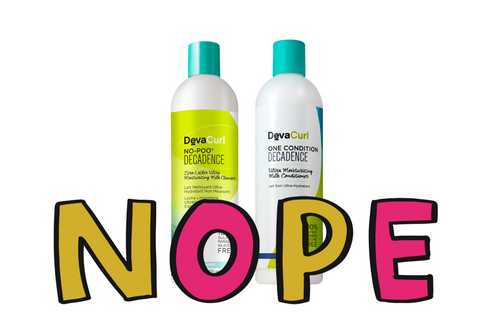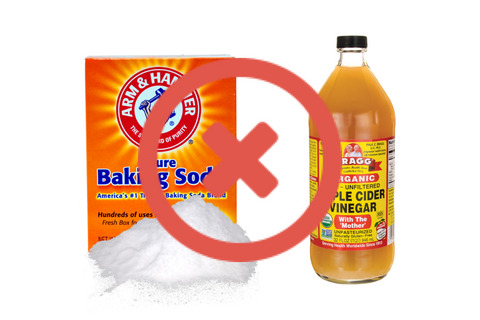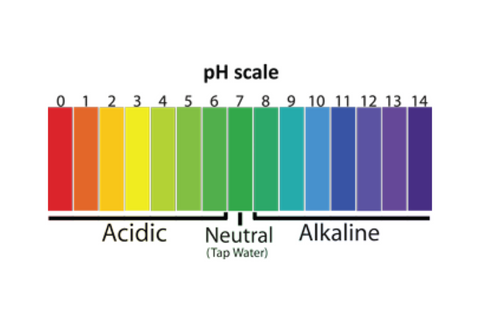Your Cart is Empty
FREE Shipping on Orders $65+ | Order by December 16th for guaranteed Christmas delivery

July 27, 2018 6 min read
If you're new to going natural in your personal care routines, you've probably spent a fair amount of time on Pinterest. And while there are some simple recipes on there that are fun and cost effective, the vast majority of DIY beauty recipes out there actually cause more harm than good to your hair.
While it might be tempting to jump into the no-poo method because of its popularity, the reality is that the no-poo method does long-term damage to your scalp and hair.
Here we share with you what the no poo method is, why it's problematic, and what to use instead. Read the whole blog post or skip to the sections you want to read:

When I first started going natural with my personal care products, choosing a cleaner shampoo and conditioner was high on my list. Before I started reading labels, I was using DevaCurl’s No Poo Cleanser (not the same as the no poo method – confusing, I know) and their One Condition.
DevaCurl seemed like the logical product choice for me – after all, my hair salon uses, stocks, and recommends their products and they’re a globally recognized brand for curly and wavy hair. But once I found out that DevaCurl uses formaldehyde-releasers as their preservatives, it was easy to decide to stop using their products.
Since the original posting of this article, DevaCurl has since been subject to a class action lawsuit due to users experiencing significant hair loss. Just another reason to cut DevaCurl out of your life.
Initial searches on Google and Pinterest lead me to the “no poo method,” which seemed like the holy grail for earthy crunchy people who wanted a safer alternative to their conventional shampoos. The number of posts about people using this method is overwhelming, so I figured if it’s this popular it’s worth a shot. But alas, just because something is popular doesn’t mean that it’s a good idea.
The “no poo” method asserts that all you need to effectively and safely wash your hair and scalp are: baking soda and diluted apple cider vinegar. Actually, some proponents of the “no poo” method say to use straight-up apple cider vinegar (*cringe*).
Not yet knowing any better about the anatomy & physiology of the hair and scalp, especially with regard to pH, I set out giving this method a try. Every 2-3 days I would wash - or more accurately, scrub - my scalp with the baking soda, then rinse out thoroughly. I then sprayed a diluted apple cider vinegar mixture using a 3:1 ratio of water to vinegar from scalp to roots, let sit for a minute, then rinse out thoroughly. That was it for my wash and condition routine.

My inner cheapskate was thrilled about all the $$$ savings on this new routine, but after noticing my hair feeling brittle and dry, I decided it was time to do some more digging.
I quickly learned why the “no poo” method is a one-way ticket to dry, brittle, damaged hair and an irritated scalp. Let me explain why:
Baking soda has a pH of ~9.5. Even when diluted like some Pins talk about, the pH will not get much lower than ~8. Our scalp & hair has a natural pH of ~4.5 thanks to our acid mantle, a thin film on the surface of our skin which acts as a barrier to bacteria, viruses, and other potential contaminants and irritants.
Using baking soda to “wash” your scalp will literally destroy your acid mantle, skin, and hair. Also, it is impossible to avoid over-exfoliating your scalp when cleansing with baking soda. Exposure to highly basic solutions will cause the hair’s cuticle to “open up,” which causes frizz, dryness, and susceptibility to breakage and damage. Ultimately, cleansing with baking soda makes your scalp more prone to infection, irritation, and inflammation, and an unhealthy scalp breeds unhealthy hair.

Straight-up apple cider vinegar has a pH of ~2, and properly diluted you can get an ACV mixture to have an appropriate pH of ~4.5. Regardless, “washing” your hair and scalp with baking soda then following up with a much more acidic solution is chemically shocking your hair cuticle. The baking soda causes the shingle-like tiers of the outermost layer of your hair to “open up,” and the apple cider vinegar solution is supposed to “close” and “smooth” these shingles back down.
Not convinced about the importance of pH? Keep in mind: the pH scale is logarithmic, not arithmetic. That means that baking soda is 1000X more alkaline than skin and hair, and straight up apple cider vinegar is 150X more acidic than skin and hair. You can't argue with math.

Many people who have tried the no-poo method for several months note that their hair becomes thinner and falls outmuch more than their usual shedding. If you ever use heat styling appliances, the damage will happen even faster.
Once I fully understood the anatomy & physiology of our hair and skin along with the importance of products with the appropriate pH, I dropped the no-poo method like it was hot and I set out doing research & development of what became our Shampoos, Conditioners, and Post-Wash Herbal Lemon Rinse.
I totally appreciate the sentiment behind the no-poo method: that most conventional shampoos are loaded with harsh cleaning agents and a plethora of less-than-ideal ingredients. However, that doesn’t mean that your only option is baking soda and apple cider vinegar! In fact, if you're invested in the long term health of your hair and scalp, the no poo method is not a viable alternative to conventional shampoos. But don't fret, we've got you covered.
If you’re looking for a truly safe and effective hair cleansing routine, look for sulfate-free, low-sudsing shampoo and silicone-free, water-soluble conditioner. Even if you don't shop with us, make sure to look for these qualities in whatever brand you choose to purchase.
Sulfate-free, low to no-suds hair cleanser. Remember: just because a formula is sulfate-free doesn't mean that it's suds-free. It's very possible to find a sulfate-free formula that's stripping.
Our sulfate-free, low-suds Shampoos come in two formulas for different hair types and textures. Our Fresh & Lively Shampoo is designed for normal to oily hair and fine hair textures that are easily weighed down. The Fresh & Lively formula gives you smooth, shiny, voluminous, and healthy locks.
Our Soft & Lustrous Shampoo is designed for normal to dry hair and curly hair textures. Our Soft & Lustrous Shampoo gives you frizz-free, shiny, bouncy, and healthy locks.
Silicone-free, water-soluble conditioner and/or finishing rinse. Look for a product that has a balance of water-soluble and oil- or fatty-alcohol-based ingredients. Find a product that has a small to moderate amount of sulfate-free surfactants (not listed among the first three ingredients) so that you’re reducing your likelihood of buildup and allowing for easy product distribution.
Our silicone-free, water-soluble Conditioners come in two formulas for different hair types and textures. Our Lightweight Conditioner gives you voluminous, silky hair and is designed for normal to oily hair and fine hair textures prone to buildup.
Our Moisture Rich Conditioner gives you frizz-free, bouncy hair and is designed fornormal to dry hair and curly hair textures. It's thin enough to easily work through hair while also offering deep moisture and nourishment.
The idea of not using harsh foaming shampoos is great – but using baking soda and apple cider vinegar is NOT an acceptable alternative. It causes long-term damage to the health of your hair and scalp.
Don't throw out the baby with the bathwater - rather than ditching all professional haircare, instead look at your ingredients and choose your products wisely.
Until next time,
Gabi Day
Comments will be approved before showing up.